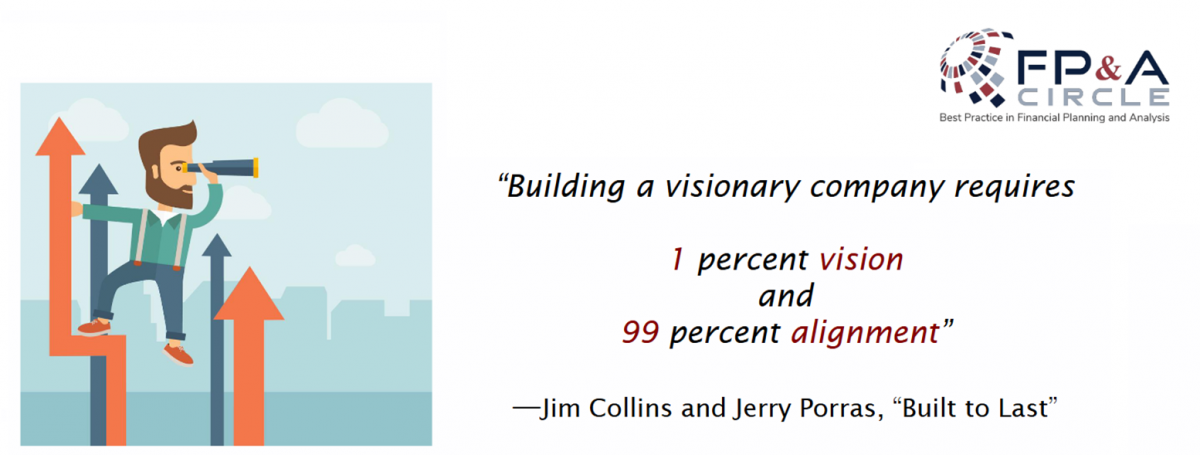Although there have been a large number of publications on the topic of strategy, only a small number of business leaders are confident that they can achieve 80% or more of their strategic goals. Why is this the case and how do we tackle this gap? This article looks at the role of FP&A in connecting strategy and people, collaboration and the role of technology. It is based on the insights from the Digital London FP&A Circle that was held on the 22nd of April 2021.
Linking strategy to plans
Michael Coveney, analytics thought leader and author, refers to the “fog of uncertainty” to describe the distraction most organisations face on their journey to achieve their strategic goals.

There are three practical steps to demist this obstacle.
Make strategy visible in plans and reports. It is FP&A’s role to ensure that strategy is the focus of everyone in the organisation. However, traditional management reports do not lend themselves to making strategy visible. Michaels proposed an alternative way of reporting where the initiatives are separately tracked from the baseline and expected outcomes and available resources are clearly stated.
Continually assess strategic initiatives. Organisations should continually review the various opportunities and assess what the appropriate combinations can change the outcome. These initiatives should be tracked separately to arrive at the current plan.
Use a suitable analytic platform. FP&A needs to make sure that the right tools are used. An integrated platform is a way forward. An integrated platform has everything in one place from data, modelling and reporting and allows for collaboration.
A balanced approach to strategic planning
In the experience of Sergey Oreshkov, Director Finance Business Partner OSCO EMEA at Barry Callebaut Group, there is a disconnect between the executors of the strategy and those who make the strategic plans. It falls onto FP&A to connect the strategy to those who are in the field implementing the strategy by communicating the strategy in a way that people can relate to as well as translating the strategy and initiatives into tangible and measurable actions.
To achieve the above, FP&A need to work closely with operations to ensure that strategy resonates with them. This will help to make strategy tangible and meaningful. Through working with operations closely on the implementation, FP&A can ensure that the whole organisation is connected and aligned in its actions to deliver the strategy.
FP&A also needs to strike a balance in the strategic planning process between being too rigid and static to become more agile and adaptive. This balance can be achieved through continuous review, collaboration and the advance of technology.
The 4 Ps in strategic planning
An interesting 4P approach to collaboration came from Michael Huthwaite, Corporate Finance Director at Walmart:
Purpose. We need to move away from the traditional KPIs in performance management towards a more performance bottleneck approach. This approach looks at how cash moves through the business. Note that cash flow here refers to the movement of funds throughout the business and not a line item in the financial statement as it is traditionally described.
People. By moving towards a collaborative approach away from the traditional accept-or-reject-silo way of working, FP&A encourage discussions, debates and exploration of more options.
Processes. Traditionally, the planning horizon is arbitrarily fixed, and the process is reset when the timeframe expires. The modern FP&A should take a continuous lifecycle approach. This starts with identifying the problem, quantifying the cost for solving the problem, assessing the product market and planning around the life cycle of growth, maturity and decline. It is important to constantly review the life cycle stages from a strategic planning perspective and DCF is a good evaluation tool for this.
Platform. Planning should not be a static and fixed horizon exercise. Modern FP&A should move towards an always-on approach where strategic, financial and tactical planning are connected. At the strategic level, there is a continuous screening of risks and opportunities which are discussed to arrive at agreed targets. Note that not all risks and opportunities will be acted upon. The targets are cascaded down and reflected in the financial plan which can then be re-evaluated through forecasting. The tactical layer looks at the initiatives that support the plan and drive the business forward. This final part promotes accountability.
The role of technology
According to Oliver Sullivin, Head of FP&A Solution Consulting at Unit4, via a connected platform and a centralised approach to data and analytics, people can have greater accessibility to the data and analytics. Increased accessibility means more visibility and constructive discussions which in turn promote more agility in responding to the changing environment.
Because numbers alone do not tell the story, technology needs to connect the qualitative with the quantitative i.e. communicate the story behind the numbers. This allows a joint up approach to strategic planning so that the business can understand the constraints and what can be achieved. Oliver shared an example of how an integrated tech platform can deliver this. Strategy is recorded in terms of tangible goals, objectives and KPIs which can be actioned, measured and analysed. Tech also needs to turn data into information that enables the 4Ps to be connected and drives strategy alignment and execution. The choice of tool is as important as the way the tool is used. It is important that whatever tool is used, it should be designed with a strategic planning process in mind.
Conclusions

At the end of the webinar, the panellists shared the key takeaways:
Communication is key and foremost to strategy alignment. FP&A should ensure that strategy and objectives are communicated in a way that is understood by the people who will be implementing the initiatives.
As technology advances, the collaboration of strategy, people and processes is the next stage of the evolution in strategy planning.
The 4Ps should be connected to the 4Cs of cash flow, collaboration, communication, being connected.
The strategic planning process is a journey that involves increased visibility, increased collaboration and continual assessment.
We are very grateful to our partner and sponsor Unit4. To watch the full webinar recording, please check out this link.







